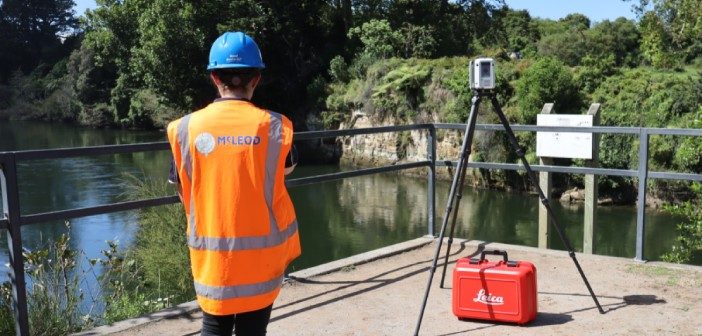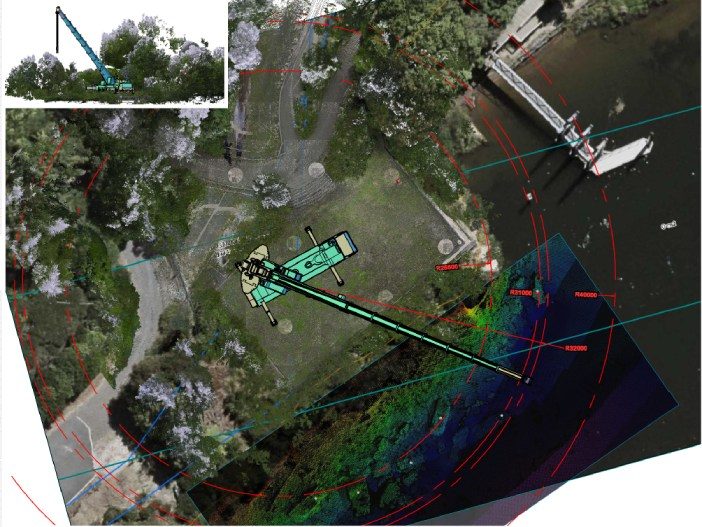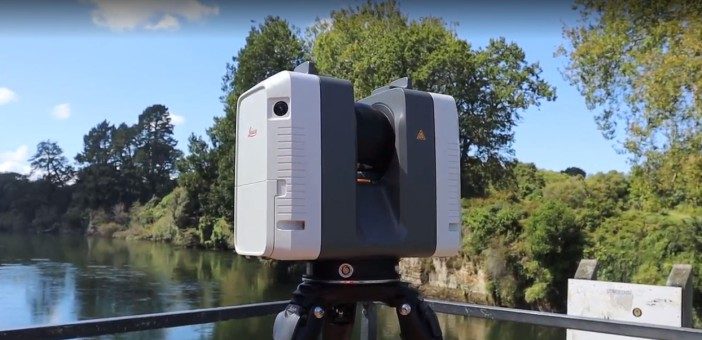
Did you know there are approximately 200 cars on the bottom of the Waikato Te Awa River? The Leica RTC360, a 230 tonne crane and bathymetric sonar have all been key elements in the cleanup efforts of this debris.
It’s a picture perfect autumn day in the Waikato as we join the McLeod Cranes team onsite for the community-backed “Beyond The Surface Project”. This legacy project has been pioneered by local organisation Deep Dive Division and focusses on identifying and salvaging submerged targets in the Waikato river, and putting a plan in place to restore the health, educate and protect the river on an ongoing basis.
We meet the salvage team at the picturesque Hamilton Gardens on the banks of the river, this site has been a popular swimming spot for Hamilton locals and tourists for decades, with the Waikato Explorer cruise boat using the jetty here to onboard/off board passengers. Few visitors would be aware of the amount of abandoned debris that has accumulated over the years and now sits clogging up the river bed.
“When we heard about this project to clean up the mighty Waikato river, our team jumped at the chance to come on board and offer our expertise. This project is personal for us, generations of our families have swum at this spot, and the river provides drinking water for millions of people, so it deserves to be restored and respected.” – Scott McLeod – Managing Director, McLeod Cranes
The Beyond The Surface Project is two-fold, the first stage involves using sonar to identify and map where salvageable debris is located underwater, and then making a plan to retrieve the identified targets. This is where local cranes specialists, McLeod’s Cranes come into the picture, they’ve teamed up with Deep Dive Division to assist with the salvage operation.
Preparation is everything
Significant preparation has gone into the salvage day. The site has been captured using their Leica RTC360 laser scanner to scan the river bank and produce a dense point cloud of the environment.
Laser scanning for heavy machinery movement is a under-utilised use case. By generating a surface of the river banks and combining with the Deep Dive Division sonar data, McLeod Cranes were able to plan movements of the 230 tonne crane around the river banks.
Scanning with the Leica RTC360 laser scanner is a vital step in ensuring that the crane can efficiently move around the site. By having an accurate layout of site, the correct crane for the job can be selected and clearances for crane movement can be calculated and planned. Effective lift plans can be constructed from the mm precision surface information that the laser scanner provides.
This saves time and money as the need for site revisits is diminished – these costs can be particularly hefty when moving a 230 tonne crane!

Multibeam Echosounder bathymetric data shown is courtesy of Mercury/DML
“We typically use the laser scanner as part of our preparation phase prior to a complex job like this one. Being able to interact with the site in 3D really informs our planning for the site, we use the data to accurately asses important aspects of the job, such as access and reach of the cranes and can then make decisions on the right equipment and resources needed. It also helps us build a robust health and safety plan and identify any hazards early too. We can then be confident that we’ve gone through process and considered all outcomes, before our crew turns up onsite.” Georgia Stumpp – Lift Planner and Project Engineer, McLeod Cranes
Visualising the job in 3D before it starts informs the McLeod’s team in number of ways:
- Situational Awareness: By virtually exploring the site, they can better understand the environment they’ll be working in, enabling them to perform more efficiently and safely.
- Hazard Identification: VR technology allows the team to identify potential hazards and risks before arriving onsite, helping to prevent accidents and delays.
- Lift Plan Feedback: Review the lift plan and provide valuable feedback based on the virtual experience, ensuring a seamless execution on the day of the lift.

Once a digital record of the site has been captured, it can be used in a multitude of ways to inform the job. It’s an effective tool to be able to communicate to the wider team what the job involves and ensure that every detail is considered beforehand.
| “In many ways, this is the perfect application for the RTC360 and a good example of the versatility of laser scanning technology. What’s been exciting for me about working with the McLeod’s team, is their positive energy, they are real problem solvers who think outside of the box.” – Kirsty Mackie – Autonomy and Reality Capture Specialist, Global Survey |  |
The Salvage Operation
Deep Dive Division divers performed the necessary rigging work to prepare the debris for removal. They have to deal with low visibility, floating debris, sharp objects and a strong 5-knot current. The McLeod Cranes team donated their time and one of their 230 tonne cranes to enable the safe and efficient extraction of the debris from the river.

The Hamilton Gardens location is one of 8 sites along the river that had been identified for salvage operations. The mapping team had identified numerous items to be removed from this site and at the end of the day, the team had salvaged 6 cars, a motorbike, several e-scooters, 5 bicycles and approx 1.5 tonne of metal debris out of the river.

“There’s a great team onsite working together and it’s an amazing feeling to complete this salvage job. Environmental projects like this are the backbone of our community, so we couldn’t be prouder to put our knowledge and resources to use here and help leave a cleaner legacy” – Scott McLeod – Managing Director, McLeod Cranes
Read more case studies on the McLeod Cranes website and contact Deep Dive Division for info on the Beyond The Surface Project
Connect with Kirsty Mackie on LinkedIn for more content on NZ reality capture projects.
SHARE THIS ARTICLE


